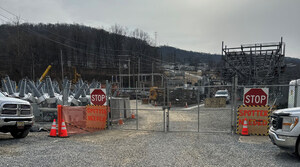FirstEnergy Generation Corp. Announces Plans to Reduce Operations at Smaller Plants
AKRON, Ohio, Aug. 12 /PRNewswire-FirstCall/ -- FirstEnergy Corp. (NYSE: FE) announced today that its FirstEnergy Generation Corp. subsidiary plans to make operational changes at certain of its smaller coal-fired units in response to the continued slow economy and lower demand for electricity, as well as uncertainty related to proposed new federal environmental regulations.
The changes – which affect Bay Shore units 2-4 in Oregon, Ohio; Eastlake Plant units 1-4 in Eastlake, Ohio; the Lake Shore Plant in Cleveland, Ohio; and the Ashtabula Plant in Ashtabula, Ohio – are designed to reduce operating costs and provide more predictability while maintaining availability for future operations, as needed. Efforts will be made to reassign affected employees to other FirstEnergy facilities.
"While we've seen signs of economic recovery in the first half of this year compared with 2009, customer demand is still well below 2008 levels," said Gary R. Leidich, executive vice president of FirstEnergy and president of FirstEnergy Generation Corp. "As a result, our smaller, load-following plants have been called upon to operate less frequently. By reducing operations at these facilities, we will better match our generation with our expected customer loads and position our company to comply with ever increasing environmental regulations."
During the period of September 2010 through August 2011, the affected units will operate with a minimum three-day notice and in response to customer demand, such as during summer and winter extreme weather conditions, when we anticipate that the units will dispatch more frequently.
Beginning September 2011, for approximately 18 months, the Bay Shore and Eastlake units will be available only in the winter and summer months, and the Ashtabula and Lake Shore plants will be temporarily idled.
As a result of the operating changes at the plants, the company estimates it could write off up to $287 million in value related to the assets. This write off could result in a reduction of up to $0.59 per share of common stock in the third quarter of 2010.
The changes are subject to review by the Midwest Independent Transmission System Operator (MISO), PJM Interconnection and the independent market monitors to ensure that there is no negative impact on system reliability.
In 2009, FirstEnergy Generation Corp. took steps to minimize the use of these plants in response to the slowing economy. These included dispatching all the units on an economic basis and establishing a three-day start time with MISO for the Lake Shore and Ashtabula plants. Since that time, the units have been called upon to operate on a limited basis.
Together, the units have a generating capacity of 1,620 megawatts (MW). In 2009 they produced approximately 6.8 percent of the company's total generation output that year.
FirstEnergy is a diversified energy company headquartered in Akron, Ohio. Its subsidiaries and affiliates are involved in the generation, transmission and distribution of electricity, as well as energy management and other energy-related services. Its seven electric utility operating companies comprise the nation's fifth largest investor-owned electric system, based on 4.5 million customers served within a 36,100-square-mile area of Ohio, Pennsylvania and New Jersey; and its generation subsidiaries control more than 14,000 megawatts of capacity.
Forward-Looking Statements: This news release includes forward-looking statements based on information currently available to management. Such statements are subject to certain risks and uncertainties. These statements include declarations regarding management's intents, beliefs and current expectations. These statements typically contain, but are not limited to, the terms "anticipate," "potential," "expect," "believe," "estimate" and similar words. Forward-looking statements involve estimates, assumptions, known and unknown risks, uncertainties and other factors that may cause actual results, performance or achievements to be materially different from any future results, performance or achievements expressed or implied by such forward-looking statements. Actual results may differ materially due to the speed and nature of increased competition in the electric utility industry and legislative and regulatory changes affecting how generation rates will be determined following the expiration of existing rate plans in Pennsylvania, the impact of the regulatory process on the pending matters in Ohio, Pennsylvania and New Jersey, business and regulatory impacts from American Transmission Systems, Incorporated's realignment into PJM Interconnection, L.L.C., economic or weather conditions affecting future sales and margins, changes in markets for energy services, changing energy and commodity market prices and availability, replacement power costs being higher than anticipated or inadequately hedged, the continued ability of FirstEnergy's regulated utilities to collect transition and other charges or to recover increased transmission costs, operating and maintenance costs being higher than anticipated, other legislative and regulatory changes, revised environmental requirements, including possible greenhouse gas emission regulations, the potential impacts of the proposed rules promulgated by EPA on July 6, 2010, in response to the U.S. Court of Appeals' July 11, 2008 decision requiring revisions to the Clean Air Interstate Rules and the scope of any laws, rules or regulations that may ultimately take their place, the uncertainty of the timing and amounts of the capital expenditures needed to, among other things, implement the Air Quality Compliance Plan (including that such amounts could be higher than anticipated or that certain generating units may need to be shut down) or levels of emission reductions related to the Consent Decree resolving the New Source Review litigation or other similar potential regulatory initiatives or actions, adverse regulatory or legal decisions and outcomes (including, but not limited to, the revocation of necessary licenses or operating permits and oversight) by the Nuclear Regulatory Commission, Metropolitan Edison Company's and Pennsylvania Electric Company's transmission service charge filings with the Pennsylvania Public Utility Commission, the continuing availability of generating units and their ability to operate at or near full capacity, the ability to comply with applicable state and federal reliability standards, the ability to accomplish or realize anticipated benefits from strategic goals (including employee workforce initiatives), the ability to improve electric commodity margins and to experience growth in the distribution business, the changing market conditions that could affect the value of assets held in FirstEnergy's nuclear decommissioning trusts, pension trusts and other trust funds, and cause it to make additional contributions sooner, or in an amount that is larger than currently anticipated, the ability to access the public securities and other capital and credit markets in accordance with FirstEnergy's financing plan and the cost of such capital, changes in general economic conditions affecting the company, the state of the capital and credit markets affecting the company, interest rates and any actions taken by credit rating agencies that could negatively affect FirstEnergy's access to financing or its costs or increase its requirements to post additional collateral to support outstanding commodity positions, letters of credit and other financial guarantees, the continuing decline of the national and regional economy and its impact on the company's major industrial and commercial customers, issues concerning the soundness of financial institutions and counterparties with which FirstEnergy does business, the expected timing and likelihood of completion of the proposed merger with Allegheny Energy, Inc., including the timing, receipt and terms and conditions of any required governmental and regulatory approvals of the proposed merger that could reduce anticipated benefits or cause the parties to abandon the merger, the diversion of management's time and attention from our ongoing business during this time period, the ability to maintain relationships with customers, employees or suppliers as well as the ability to successfully integrate the businesses and realize cost savings and any other synergies and the risk that the credit ratings of the combined company or its subsidiaries may be different from what the companies expect and the risks and other factors discussed from time to time in its Securities and Exchange Commission filings, and other similar factors. The foregoing review of factors should not be construed as exhaustive. New factors emerge from time to time, and it is not possible for management to predict all such factors, nor assess the impact of any such factor on FirstEnergy's business or the extent to which any factor, or combination of factors, may cause results to differ materially from those contained in any forward-looking statements. FirstEnergy expressly disclaims any current intention to update any forward-looking statements contained herein as a result of new information, future events, or otherwise.
SOURCE FirstEnergy Corp.
WANT YOUR COMPANY'S NEWS FEATURED ON PRNEWSWIRE.COM?
Newsrooms &
Influencers
Digital Media
Outlets
Journalists
Opted In





Share this article